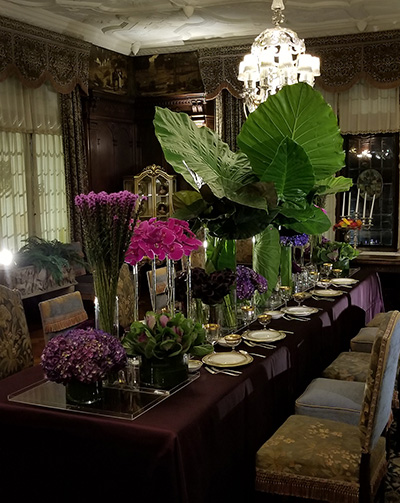
This tabletop arrangement was created by floral designer Scott Robertson of Stems Fleur of Cleveland, Ohio. The display was for Inspirations in Bloom, benefiting the historic Stan Hywet Hall in Akron, Ohio. / Photo by Scott Robertson.
THIS WEEKEND promises the first snap of fall weather, and the annual issue of hauling the tropics in to my little greenhouse.
Space must be found for the palms, the jasmines and the hibiscus, and most particularly the mother of all elephant ears, a giant that wintered over last year that grew over the summer to monstrous size.
Topping six feet in height, with a spread several feet wider, and three-foot-long leaves, the thought of moving it intact is impossible, while cutting it back feels tragic.
And then.
I came across a photo the other day on a Facebook page devoted to elephant ears that had me and a few hundred other followers in a dead swoon.
A dining table laid out grandly with gold-bordered china on purple linen, with a centerpiece of deep violet orchids, fuzzy purple liatris and a sprinkling of purple hydrangeas arranged by single stems in glass beakers. And in the middle, tickling the dangling crystals of the chandelier overhead, an explosion of elephant ears in a towering glass vase.
The work of Scott Robertson, a floral designer based in Cleveland, Ohio, the tabletop extravaganza was created for Inspirations in Bloom, part of a week-long annual juried art fair and house tour benefiting Akron, Ohio’s historic Stan Hywet Hall and its 70 acres of gardens. Robertson was one of a handful of designers selected to create displays for the 65-room mansion, the former home of F.A. Seiberling, co-founder of Goodyear Tire.
“I wanted to design a fun, modern, monochromatic tablescape,” he told me. “I wanted some drama, so I looked around my garden and thought the alocasia would be amazing on the table to go with my modern look. They’re such a great way to add decor to your home before the frost gets them. If you cut the stems you can get quite a run with them indoors in vases.”
Really? My previous experiments with cutting elephant ears were literal flops. Within an hour or so of being snipped, the giant ears curled up and limply drooped in flaccid dismay on the tabletop. Decidedly unappetizing.
It seems I was cutting the leaves of colocasias, not alocasia. Both, it turns out, are tropical, have enormous leaves and are grown from bulbs. Stay with me for a few lines here . . .
Says Wikipedia: “Alocasia’s large cordate or sagittate leaves grow to a length of 20 to 90 cm on long petioles. Their araceous flowers grow at the end of a short stalk, but are not conspicuous; often hidden behind the leaf petioles. . . . Colocasia are herbaceous perennial plants with a large corm on or just below the ground surface.”
Which is clear as mud, as far as I’m concerned. A Google search sent me wading further into the muck; both varieties are called elephant ears.
Here are two easy ways to tell the difference, if you’ve tossed the bulb tags, as I always regret doing.
Alocasia is poisonous if not thoroughly boiled. The tongue and pharynx swell, breathing becomes difficult, there’s sharp throat pain, and Hercule Poirot is called in.
Alternatively, you can cut a stem and stick it in water and if it deflates, it’s colocasia. The alocasia will remain perky for who knows how long—which is how I found out the mother of all elephant ears that I mentioned early on is an alocasia. Three days after cutting, the stem I sacrificed is still looking fresh.
Scott, who regularly produces floral fantasies at his boutique shop, Stems Fleur, intended this display for show. While it would be gorgeous on a buffet, it would only work on the dining table if you dislike your guests. Possible, I suppose. Republicans on one side of the elephants, Dems on the other.
Generally, however, you want a low centerpiece on the dining table—unless you have a very narrow, tall, clear vase, and cut three or so stems so they are well above head height, spreading like an umbrella over diners.
That would give a clear view and make even grilled cheese sandwiches grand.
—Stephanie Cavanaugh

I love elephant ears….what a beautiful table setting thanks for sharing it…